The Pump Guru NPSH Part 1 of 3 – NPSHa: The System Giveth
The Pump Guru
NPSH Part 1 of 3 – NPSHa: The System Giveth
A lack of understanding of the determination of Net Positive Suction Head (NPSH) and how it affects
your pump can have annoying or catastrophic consequences for your process.
While reviewing the tender specification for a booster pump system on a recent project, I was confronted, once again, with the general lack of understanding of what Net Positive Suction Head (NPSH) is, calculating it, and addressing it in relation to pump selection and design. One bullet in the Design Requirements for the pumps read:
.6 Available NPSH: 1m (supplier to verify based on pump height)
Does this mean that the pump is 9 metres above the liquid level in the tank? Does this mean that the pump is drawing out of a tank that is under 90 kPa of vacuum? Neither is likely and, of course, neither was true for this project. On average, 1 metre below the liquid level in the tank. But does this correspond to 1 available meter of NPSH? Of course not.
Understanding NPSH begins with understanding what it is and how to calculate it. To keep things simple, we will confine our discussion to water with a specific gravity of 1.0.
We begin with one basic fact and one basic assumption:
- We always express Net Positive Suction Head as a height of water, in either meters or feet, and as an absolute (relative to absolute zero pressure), not gauge (relative to atmospheric pressure)
- The liquid level is above the centerline of the pump. We will discuss suction-lift applications in later posts.
As long as we are dealing with a tank or reservoir that is open to atmospheric pressure, which we are, the water in the tank is exposed to the weight of atmospheric pressure. Since the pump and piping are not directly acted on by atmospheric pressure, the weight of the atmosphere has the effect of pushing the water towards the pump, therefore adding to the system’s ability to pump the water.
Available Net Positive Suction Head, NPSHa, is the total of the difference in elevation between the liquid level and the pump centerline plus atmospheric pressure expressed in metres or feet. NPSHa is the total weight of water column that is available to push water into the suction of the pump. For the project mentioned above:
Atmospheric pressure = 101.4 kPa = 10.3 metres of water column
NPHSa = 1 metre of liquid height + 10.3 metres atm. = 11.3 metres
The only exception to the above would be if we were dealing with a sealed tank, in which case we would have to add (or subtract in the case of vacuum) the actual, absolute pressure in the tank.
As you can see, adding the effects of atmospheric pressure changes the picture significantly. Most centrifugal pumps require much more that 1 metre of NPSH, which would eliminate most commercially available selections. Using the correct calculations opens up the field of options and results in the correct pump for the job.
In the next issue, we discuss the NPSH requirement (NPSHr) of centrifugal pumps in general.
The Pump Gure: October 27, 2014

